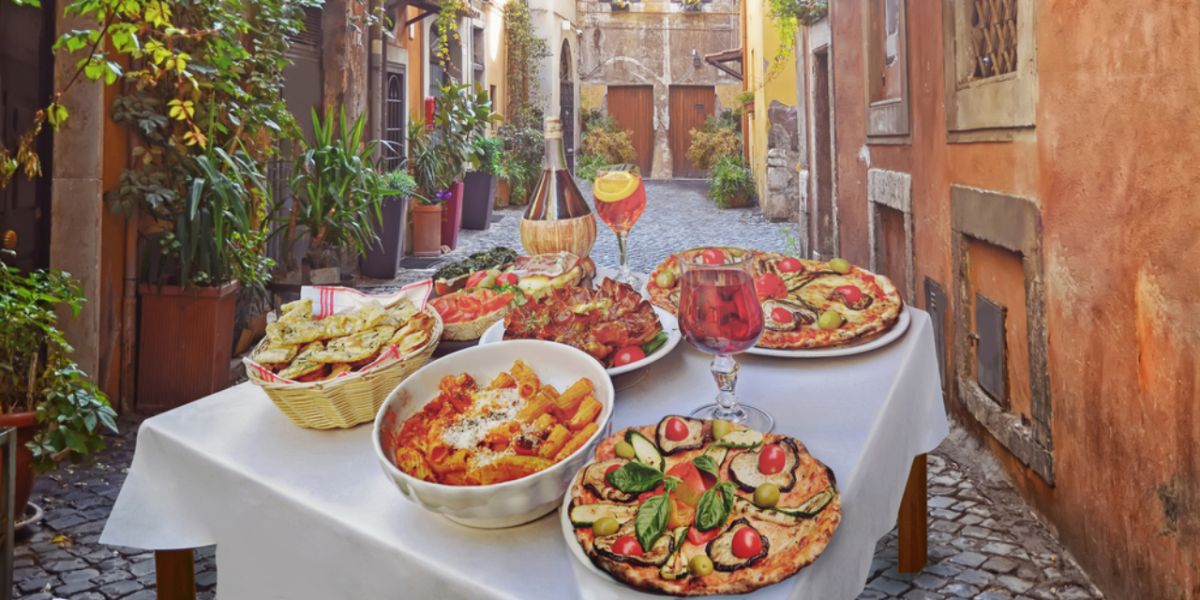
When it comes to gastronomy in Italy, you will always be surprised. Each region has its specialties that make Italian cuisine so rich. In Rome, you will find many local products and tasty, comforting dishes. The city is full of restaurants, trattorie and fast food options where you can enjoy traditional cuisine, and this is something that locals, tourists and expats alike are happy about. The culture of the Mediterranean diet is well represented on the plates of the various Ristoranti, Pizzerie, Trattorie and Osterie of the Eternal City.
Food is an integral part of Italian daily life, and Rome is no exception. It is a subject that Romans discuss with great pleasure. For example, holiday stories always include a chapter on cooking. Indeed, you will often be asked what you ate there. Unlike Milan, however, Roman cuisine has become less of a social phenomenon and has retained a more traditional feel, even though young chefs are now revisiting the Roman culinary scene.
The Italian menu
First of all, it is important to note that the Italian menu differs slightly from that of the rest of Europe. t is usually taken in the following order:
- Antipasto: the starter
- Primo: pasta dish and risotto (or minestra soup)
- Secondo and Contorno: meat and fish dishes accompanied by vegetables or potatoes
- Dolce: dessert.
You can also have a single-course meal, as the full-course meal is not the norm every day of the week but is rather reserved for occasions or weekends. When it comes to pizza, in particular, there will be neither primo nor secondo.
Roman specialties
In Rome, as in all of Italy, there are traditional dishes and preparations specific to the area, for example, fried cod fillets (filetti di Baccalà), carciofi alla Romana, carciofi alla Giudia, or Puntarelle (chicory), finely chopped and served in a fresh salad with anchovies, white vinegar and olive oil, are quite popular. Artichokes are harvested between February and April and, if fresh, will not be available in Rome's restaurants all year round.
For meat, try Abbacchio alla Scottadito, grilled chops with thyme, tarragon and rosemary, or Coda alla Vaccinara, braised oxtail simmered with tomatoes and other vegetables. Let's not forget pollo ai peperoni, juicy Roman-style chicken with baked potatoes, tomatoes and peppers, but also Saltimbocca alla Romana, veal cutlets in white wine with a slice of prosciutto crudo on top, or the famous Porchetta Romana, grilled suckling pig with herbs eaten as a dish or, more commonly, as a sandwich in bread, or Pizza Bianca, a type of focaccia.
Of course, pasta dishes are no exception and are the pride of Roman gastronomy which, traditionally, are meant to be served with Rigatoni, Penne or Tonnarelli (long pasta like spaghetti but square in shape):
- Carbonara: prepared with egg yolk, Guanciale (salted pork cheek), Pecorino Romano cheese, salt and pepper,
- Amatriciana: originating from the town of Amatrice, prepared with Guanciale, tomato and chili, Pecorino Romano,
- Cacio e Pepe: prepared with Pecorino Romano cheese, salt and pepper,
- Gricia: prepared with Pecorino Romano cheese, Guanciale, salt and pepper.
In the famous Roman pasta, there is also Gnocchi alla Romana, flat potato gnocchi served au gratin in the oven with butter and Pecorino Romano.
Guanciale can be replaced by Pancetta, a salted pork belly (although this argument is disputed by some purists!), and the type of dough can also vary from one restaurant to another according to the interpretation of each.
Pizza in Rome
Pizza also has a significant place in Rome and differs from the rest of Italy. Pizza al Taglio, a pizza by the slice (by weight) for eating on the go, is often found on every street corner and is generally crisper than the round Neapolitan pizza. Many bakeries bake bread, focaccia and pizza several times a day, called forno, literally "oven". The aroma that emanates from them is irresistible, so take advantage of it to take a gourmet break while you discover Rome! Among the specialities, try pizza bianca, pizza alla mortadella or pizza ai fiori di zucca (with courgette flowers). A good address for bread and pizza al taglio in the center of Rome is undoubtedly the Antico forno Roscioli or Forno Campo dei Fiori.
The traditional round pizzas also differ from the famous Neapolitan pizza in their dough. It is prepared with the same ingredients (flour, water, yeast and salt) but is thinner and crisper than the Naples one. As for the rest, the filling is very varied, and everyone will find something to satisfy them.
Rome is also famous for its Supplì, rice croquettes with tomato sauce, meat and mozzarella. But other flavors are available, with melted cheese, fish, vegetables, etc. Among the best addresses, you will find infinite compositions at Supplizio or Supplì Roma.
Pastries and ice cream in Rome
Pastries also play a major role in the traditional specialties of Rome. You will undoubtedly find Maritozzi, small buns (like milk bread) filled with vanilla whipped cream in bars and pastry shops. During Carnival, try Frappe, a light, crunchy biscuit sometimes flavored with white wine and lemon, either fried or baked, and in March Zeppola di San Giuseppe, a vanilla cream puff served for St Joseph's Day (Father's Day in Italy): again, there are two versions, baked or fried. The pies, Crostate, are also very popular with the Romans and can be found in various flavors, including ricotta, chocolate or gianduja cream, or fruit. Not to mention the famous Gelato, the world-famous Italian ice cream, of which Rome has some good addresses, including Gelarte, Otaleg and Neve di Latte.
Like everywhere else in Italy, coffee is a real institution in Rome, and you'll see bars on every corner. Take a break and drink your espresso or another specialty at the counter like a Roman. Cappuccino, as is the Italian tradition, is usually only drunk in the morning (so not after breakfast) with a croissant, called cornetto in Rome, usually filled with jam or cream (vanilla, chocolate, or even pistachio).
Where to eat traditional Roman cuisine
Rome is full of typical restaurants where you can try traditional dishes. You are advised to stay away from touristy streets such as the Pantheon, the Trevi Fountain, Piazza Navona and the Spanish Steps. However, some restaurants in the historic center are famous for their quality cuisine, such as Maccheroni in Piazza delle Coppelle or Roscioli, which is also a delicatessen, near Piazza Campo dei Fiori. One of the most famous restaurants to eat a good Carbonara is La Carbonara in the Monti district on Via Panisperna. If you want to try a good Amatriciana, you can also go to Bucatino in the Testaccio district, where you will also find an institution of Roman cuisine Felice a Testaccio.
If you visit the Trastevere district, despite its touristy side, you will find some good restaurants such as da Enzo al 29, via dei Vascellari 29, Cajo e Gajo, Piazza di San Callisto or Impiccetta, Via dei Fienaroli. In the same district, for a Roman-style pizza, eat at L'Elementare, but also at Peppo al Cosimato or Seu Pizza Illuminati for a Neapolitan-style pizza, and for a pizza al taglio, go to La Boccaccia pizzeria. Also in Trastevere for a drink, try the Antidoto wine bar or the Freni e Frizioni bar. Pizzeria Da Remo is an institution for traditional Roman pizza in Piazza di Santa Maria Liberatrice in the Testaccio district. In the centre, near the Parliament, try Poldo e Gianna Osteria. In the Ostiense district, don't miss Trattoria Pennestri.
In the old ghetto of Rome, there are also typical restaurants where you can eat traditional Jewish food, such as Su Ghetto and Nonna Betta, both on Via del Portico d'Ottavia. The Boccione bakery and pastry shop also offers Jewish-Roman kosher specialties. Don't miss the ricotta and cherry pie if you are passing by.
We do our best to provide accurate and up to date information. However, if you have noticed any inaccuracies in this article, please let us know in the comments section below.








